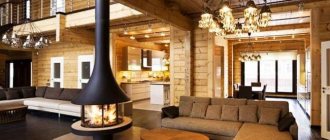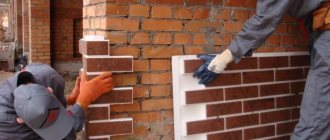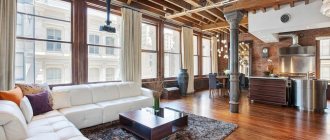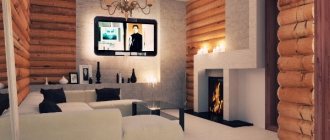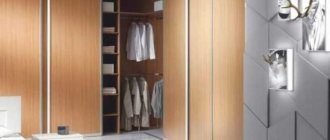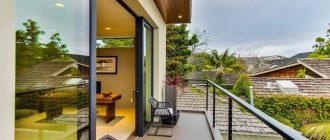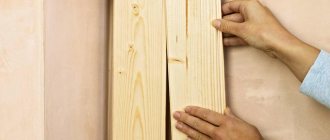Gradually, various synthetic finishing materials, such as wallpaper or plastic, are fading into the background. Natural, environmentally friendly materials are coming back into fashion. Wooden lining is just one of them. Since wood fades over time and is exposed to various types of exposure, owners of houses and apartments often have questions about how to paint the lining inside the house. The lining is suitable for both external and internal decoration. But how to use it correctly for interior spaces?
Why do you need to paint the paneling?
Many people believe that since there is no rain, snow, or wind inside the house, there is no need to paint the lining indoors.
But this is a misconception. So, why do you need to paint the lining:
- It should be remembered that the lining is made of wood. And wood catches fire easily. Naturally, no protective material will provide absolute protection against fire. But there are compounds that significantly increase fire resistance.
- Over time, the tree begins to rot. To avoid this, it must be coated with a special compound - an antiseptic. It is colorless, so the original wood texture will be perfectly preserved.
- The paint and varnish coating serves to protect against mechanical damage, taking on all impacts and scratches, preserving the beauty of the walls.
- The paint and varnish coating protects the wood from exposure to ultraviolet radiation, thereby protecting it from darkening.
- Just for beauty. If you do not want to change the natural wood color, applying a special varnish will make the wall covering brighter and shiny. Or vice versa, many paints completely hide the original wood color, preserving only the structure of the wood.
Carrying out the procedure
To paint wooden panels, paint or varnish with colors and dyes of different types and compositions is used (how to properly varnish a panel for a long time?). Application techniques and finishing methods depend on the composition of the paintwork material.
Varnish
To paint wooden panels with varnish you will need:
- check all existing lining, sort it by color and quality, exclude panels that contain falling knots or other obvious defects;
- thorough sanding is carried out until absolutely smooth to the touch is achieved;
- if necessary, cover with a special primer or apply the first base layer of varnish, leave each canvas to dry without touching the treated surface;
- if an opaque varnish is used, then repeated sanding over the painted layer is necessary;
- A second layer of varnish is applied until the color is uniform over the entire area of the canvas, and then dried.
Advice
Rejected panels can be used as test panels. On them you can see the type of coating with different numbers of layers, etc.
You can watch how to properly varnish the lining, what tools and techniques to use for this, in the following video:
Dyeing white
To create the desired decorative effect, several coloring techniques are available:
- Acrylic pigment primer diluted to 80-100% is applied like a regular varnish. It creates a coating with a long service life, but its price is high.
- Polyurethane pigment primer labeled “bleached” or “white” with a dilution of up to 80-100% also provides the desired decorative effect, but over time the color becomes yellow.
- Oil with wax - with a single-layer coating requires rubbing with a rag to preserve the wood texture; with a two-layer finish the surface is opaque.
- Tinting or staining - often found with the markings “bleached oak”, “frost” and the like. The peculiarity of the finishing is a multi-layer coating with very thin and uniform films. Otherwise, a peeling effect will form on the surface.
These methods provide different shades of white, depending most on the type of wood.
You can learn how to quickly and correctly paint the lining white from this video:
Technicians
For high-quality painting of lamellas, the following rules must be followed:
- Dry lining is processed only from the outside, and a wet panel must either be pre-dried or processed on all sides, including the ends. This is especially true for rooms with high humidity.
- The coating is applied to each plank separately to achieve an even color over the entire surface and to prevent the appearance of visible boundaries between strokes.
- When painting lining that is already installed on the wall, it is difficult to achieve maximum filling of the joints, so you need to choose a special brush.
- It is necessary to adhere to the technology recommended by experts for painting tongue-and-groove wooden lamellas.
Attention
If the quality of the first layer remains below average, then it needs to be sanded and primed again. Apply paint only to dry boards.
This approach will even out the density across the entire surface of the material to ensure a uniform shade.
Often they cover surfaces that are already installed on the wall. Therefore, the technology may differ slightly. You need to paint along the board, but with movement from one edge, for example, from one doorway to another. This will provide more even coverage as there will be no wet transitions.
Selection of necessary components
What is the best way to paint the lining inside the house?
There is simply no single correct answer. It depends on what goals you set for yourself. If you just want to protect wood from harmful external factors and parasites, then you should opt for an antiseptic. To make dull walls shine, you need varnish. And paint will help you beautifully decorate old lining with new bright colors.
All paint and varnish materials are divided into two main groups: protective and decorative. Let's take a closer look at each of them.
Protective compounds
These products are designed to protect wood from various physical factors, mechanical influences and parasites. They, in turn, will also be divided into groups, depending on the main tasks performed. Here are the main ones:
- Fire retardants. Products that are absorbed into wood and increase its resistance to fire. Recommended for use when treating interior residential premises. Thanks to the treatment, the wood will not catch fire for much longer, which will either eliminate the source of the fire faster or give the residents time to leave the premises.
- Bactericidal substances. Compositions designed both to prevent the appearance of fungi and mold, and to combat these manifestations. They also contain substances that repel various wood parasites. Thanks to them, the tree is well preserved and acquires an aesthetic appearance.
- Impregnations. Compositions that perform the functions of protection against fungal spores and parasites, as well as changing the shade of wood. Stain is very popular at the moment. It saturates the wood completely, to its full depth, giving the material a darker color and highlighting its structure well.
- Linseed oil. Used to impregnate wood. Oil-impregnated lining is insensitive to moisture and fungus, and also acquires a matte tint and a clearly defined structure.
- Drying oil. Previously, it was actively used when working with lining, but today it is rapidly losing ground. Refusal to use it when impregnating walls is due to the fact that it darkens quite quickly and begins to stick.
- Bleaches. Used to remove various defects from the surface of the lining. For example: stripes, dark spots, bluish tints. Depending on the purpose and method of use, these substances come in several types. Most of them are applied to the material at the site of the defect, left for a while, and then washed off with water.
- Primer. Provides protection for wood from mechanical influences and creates reliable adhesion of the decorative layer to the treated surface.
- Wax compounds. A traditional and very effective protective agent. Wax creates a dense layer on the surface of the wood that does not allow moisture to pass through and is resistant to mechanical stress. It is very difficult to apply evenly. Typically a primer is applied before waxing to make the process easier.
This division is very arbitrary. As already mentioned, many of these products are used separately, without a decorative coating. But their main function is to protect the wood, and giving shade and expressiveness to the structure is a secondary point.
Decorative products
Painting wooden lining with a decorative coating means that the natural color of the wood will be lost. This is usually done after a certain time, when the unpainted wood darkens, or the owners have other creative ideas.
How to paint the lining inside the house? There are many different decorative coatings that meet the tastes of even the most demanding aesthetes. These include:
- Oil paint is a long-term recognized leader in the field of materials for painting wood. It is deeply absorbed inside, thanks to which the painted surface receives reliable protection. It doesn't fade for a long time. The main disadvantage is that the paint takes a long time to dry and has a strong, specific smell. Therefore, it is recommended to carry out repair work in warm weather so that the room can be ventilated.
- Acrylic paint is better than the previous one in all respects. Acrylic paint dries quickly and does not have a strong odor, which makes it possible to carry out work at any time convenient for you. This paint for lining does not fade for a long time, maintaining its original shine, and has good resistance to moisture. The only downside is the high price.
- Acrylic aqualacs are, by all accounts, the best means for processing lining. They are an environmentally friendly product. The varnish forms a reliable decorative coating that is durable, resistant to moisture and mechanical stress.
- Alkyd varnishes - painting the lining is the main function of this type of material. Its advantages are resistance to moisture and temperature changes. Significant disadvantages are long drying time, easy flammability, high price.
- Decorative glaze – thanks to its transparency, it perfectly highlights the wood texture. To give it the desired color, you can add different colors inside.
- Opaque enamels - creates a dense layer on the wood surface, completely hiding all defects and protecting the product from mechanical damage, well suited for country houses.
Types of compositions for lining
All wood treatment products are conventionally divided into protective and decorative. Some of them need to be combined, others can be used independently. Ideally, primary processing should be carried out before installing wooden lining, so the products will be protected from adverse factors from all sides. If the siding is already installed and has a coating, it will need to be removed or sanded.
Note! Eurolining, if it is manufactured according to the standard, is already covered with protective or protective-decorative compounds.
Protective means
The primary objectives of these compounds are to protect the wood from pests, mold, mildew, moisture, temperature changes and extend the service life of the lining and finishing coating.
Coating the lining with a protective compound before installation
Common products for treating wooden surfaces:
- Primer. A popular base for decorative finishing. It improves adhesion, prevents moisture absorption and resin release, fills pores and hides minor irregularities. Compositions with an antiseptic additive are produced; they protect the tree from damage by mold and mildew.
- Oil-wax. Creates a surface of a dense film that perfectly repels water. This treatment is necessary for rooms with high humidity.
- Linseed oil. Penetrates wood deeply and hardens over time. Protects from moisture and gives the lining a distinct structure.
- Drying oil. Once a popular processing tool. Today it is being replaced by more advanced compounds. Improves the hydrophobicity of wood, but the coating quickly changes color and sticks.
- Bleach. The material is more often used topically, where there are defects such as blue spots or natural darkening.
- Antiseptics. Protect the surface from pests, fungus and mold. They are also used on affected areas of the finish.
- Fire retardants. Reduces the ability of wood to ignite and spread fire.
Oil-wax and linseed oil do not require additional processing, as they give the surface a pronounced pattern, and the color can be tinted. It is also permissible not to paint drying oil, but it will have to be renewed frequently. Primer and antiseptics are used as a base for finishing.
Lining coated with drying oil
Decorative coatings
These compositions must be selected taking into account the condition of the finish. There are products that preserve and emphasize the natural appearance of wood, make annual rings more pronounced, and add color. Others, on the contrary, hide the design under a thick layer of color. The first ones should be used if the lining has no defects (grades Extra, A and AB) and old paint. Second, for products with numerous damages (grades B and C) and coatings that cannot be removed.
Transparent compositions for finishing wooden lining: varnishes, stains, some paints. Opaque: acrylic and oil paint, water-based.
Lucky
Acrylic, alkyd and water-based varnishes are most suitable for interior work. Completely preserve the natural appearance of wood. You can add pigment to the composition, which will give the lining a tint. The varnished surface has a glossy or matte texture. Additionally, they protect the finish from moisture, discoloration and minor mechanical damage. May contain antiseptic additives.
Varnish coating for lining
Decorative azure
Gives wood a distinct structure and any color. It does not form a film on the surface, but penetrates deeply. The material is transparent, so the lining underneath should be without significant defects. In addition to decorative, it performs a protective function.
Options for shades of decorative azure
stain
It has almost the same effect as decorative azure. Paints wood a rich brown color in different shades. Stain is often used to artificially age lining. It is important to consider that it does not protect enough from moisture.
Shades of stain
Acrylic water-based translucent paint
Forms a thin layer on the surface of the wood, through which the texture and natural shade of the wood are visible. Such paints hide minor finishing defects.
Translucent paint on lining
Oil paint
Thick opaque coating. Forms a film on the surface. Can have any shade. Maintains color and integrity for a long time. This lining paint requires updating approximately every 5 years. Has a pungent odor.
Coating the lining with oil paint
Acrylic paint
A more durable opaque finish than oil paint. It has virtually no odor and dries in a short time. Can create matte and glossy finish. Its only drawback is its high cost.
Matte acrylic paint finish
Water-based
The paints are odorless and dry quickly. They form a matte or semi-matte texture. Suitable for dry rooms only.
Water-based paint for decorating a country house
The video shows an example of a competent combination of protective and decorative coatings for lining, applied at home, without the use of special tools.
Tips for choosing coverage
When choosing what to paint the lining with, you need to keep these points in mind:
- Oil paint dries quickly, but becomes lighter over time. Therefore, when choosing which paint to paint, dark or light, it is better to choose the first option.
- Painting lining inside a house is a painstaking task. For decorative coatings, it is best to use water-based paint. This is a 100% environmentally friendly product. You can work with it at any time of the year.
- How to paint the lining inside a country house? It is best to choose alkyd varnish. It is durable, resistant to moisture, mold and mildew.
- Eurolining can be painted with transparent polyurethane varnish. It emphasizes the texture and “naturalness” of wood.
- Another good paint for lining is acrylic. It does not change its color for a long time.
- How to paint a clapboard ceiling? Do not use water-based paint. It is better to opt for alkyd varnish or choose oil paint. These products do not spread and dry quickly. You can paint the ceiling without any problems.
On video: the best way to paint wood.
How to paint the lining inside the house? Let's look at the main types of coatings
Talasimov Denis Kirillovich consultant, technologist
Lining is a trendy building material that acts as a universal interior decoration. Treated wood can have a varied profile: from a perfectly smooth surface to carved, wavy decorative elements. This facing material has a number of significant advantages: cheap, affordable, quite beautiful and easy to use.
But wood does not always fit well into the interior, and sometimes owners simply want to radically change the design of the decoration. Also, with a lack of ventilation or a large amount of sunlight, this lumber irreversibly changes its appearance.
What is the solution in this situation? — Painting the lining is the fastest way to change the interior decoration of a room as much as possible. It transforms wood, turns it into a stunningly beautiful material.
What will you learn about in the article?
- Video: what lining painted in our workshop looks like
- Is it possible to paint the lining inside the house?
- How to paint lining inside a house: 6 main types of paint
- Video: how to prepare lining for painting
- The two most popular options for painting lining
- Choosing a working tool: options for painting lining inside the house
- Spray gun: all the pros and cons?
- How long does painted lining last?
Video: what lining painted in our workshop looks like
Is it possible to paint the lining inside the house?
There is a legend that paint contains chemicals that subsequently negatively affect the human body. Oh, mom, what do these smart guys talk about on the forums, we are already tired of them, really tired. A customer comes to the office and, with phrases memorized from the Hausa forum about terrible and dangerous paint, begins to criticize everything around...
Photo 1. Artificially aged wood
Responsible employees, based on their eight years of experience working with wood, authoritatively declare: painting lining in a wooden house is safe
. And, if all standards are followed, it is extremely effective. In our work, our company uses exclusively certified paints and impregnations that are used indoors and are not dangerous for people or pets (hazard class M-1).
How to paint lining inside a house: 6 main types of paint
Painting lining is a delicate, complex matter, and it is best to entrust it to those who paint and have painted a lot and have experience. You will be able to carefully work out the idea, select materials, and at the end you will receive the planned result of the work. Painting the panels inside the house in different colors is possible using different compositions, for example, opaque or translucent.
Photo 2. Finishing with patinated clapboard
Protective impregnations
Most often they give only a matte or satin shine. A very good option when you need to paint quickly. Used both inside and outside the house. For example, the Woodex line from Teknos. And there is also such a product as Tikkurila Pinja Wood Oil, it is cheap, lasts a long time both inside and outside the house, in general, it is a universal impregnation, ask our managers, you will not regret your choice.
Tonics and stains
They allow you to control the degree of “shading” of the wood pattern and retain all the initial properties of the lumber. The lining will be painted in one or several layers to achieve the desired effect. Impregnation primers can be used in decor if the task is to slightly tint the wood, but leave it in its original form. Suitable for interior decoration. Most often, stains are covered with varnish. If you don’t want to do this, then it’s better to use the impregnations from the paragraph above.
Photo 3. Local finishing with painted lining
Pigmented, tinted oils
They play the role of protector and colorist, giving the shade a certain degree of saturation with a silky, matte shine. They do not create a weighing film and repel dust and dirt. When used for floors, countertops, etc., they are covered with hard wax on top to protect against abrasion. For lining it can be used without wax. Eco-friendly, safe, natural.
Colored waxes
The inside does not require a mandatory primer and is distributed in an even layer. They have excellent aesthetics and a fairly wide palette of colors. Just a gift for those who want to paint themselves. Wax - this one is very beautiful and environmentally friendly. For example, the product Teknowaks Teknos. This coating is easy to work with; just two layers transform the wood. Very beautiful coating.
Photo 4. Painting the lining with colored waxes
Varnishes for wood
You can choose the color and choose the degree of gloss. They form a beautiful film on the surface, significantly extending the service life of the material. Eco-friendly water-based materials. You can set any shade using a stain primer. The varnish schemes are very beautiful. You can choose any level of gloss, from gloss to matte.
Covering paints
They fundamentally change the color of the finish and completely hide the texture of the wood. If the task is to achieve rich, bright colors, covering paint will help solve it.
Don't know what paint to paint the lining? Then take a look at the catalog, which presents popular manufacturers of paints and varnishes, as well as their products.
Photo 5. Angarsk pine paneling under topcoat paint
Video: how to prepare lining for painting
The two most popular options for painting lining
Painters most often use two types of tinting compounds: varnishes or waxes. Each product has its own advantages.
Main advantages of varnish
- Modern scuba tanks are completely non-toxic and environmentally safe for use inside the home.
- Water based - no odor.
- Keeps the shade of wood in an ideal form, does not turn yellow over time from the influence of ultraviolet radiation.
- A high degree of adhesion will allow it to be used on different types of wood.
4 reasons to choose wax
- Due to the higher density of the liquid, it effectively hides surface defects.
- Modern waxes dry in half an hour and are used economically.
- Doesn't clog pores and is easy to apply.
- Perfectly smooth, matte surface, velvety to the touch.
Our company is always aware of current trends in wood painting. Take a closer look at wax with the safe composition Teknowax.
Photo 6. Hemming the ceiling with painted clapboard
Choosing a working tool: options for painting lining inside the house
What is better to paint the lining - with a brush or a roller? Still in doubt, but hundreds of articles you’ve read don’t give you an answer? We collected the opinions of our experienced painters, highlighting the main parameters of each of the tools.
Brushes are a must have when painting
Is it possible to paint lining with a brush? Certainly! But you should purchase only specimens made of smooth, thick, dense bristles so that they do not begin to fall out during surface treatment. Flat - suitable for any paint and varnish materials; with its help you can make even finishing strokes. Due to its size, the muck hood is only suitable for priming work.
Photo 7. Finishing the ceiling with painted lining
For varnish it is better to choose softer bristles, but for oil - harder ones, which will allow you to stretch the dense mass into an even layer.
Pay attention to the shape of the brush: it is desirable that it is not rectangular, but with rounded edges, which will greatly simplify the installation of paintwork materials. Don't want to spend money on expensive factory brushes? Just trim the bristles (make the brush round) using scissors yourself! The brush is suitable for liquid substances. The roller is the ideal companion for large areas.
Using modern rollers of various shapes with a minimal degree of absorption, you can prime a significant volume of facing material in a matter of hours. With enough skill, you can even try applying tinted oil to wood, this will significantly speed up the painting process. But the roller is still incompatible with many compounds; it will stain too much. So the brush is a priority.
Photo 8. Finishing the ceiling with painted lining
Spray gun: all the pros and cons?
The spray gun is a technique with character that requires skill. Aerial models will paint the paneling of the most complex shapes, but at the same time fill the entire room with a cloud of paint drops. The airless option will protect against the appearance of paint mist, but it is only suitable for painting straight surfaces. Combined spray guns have maximum efficiency, but without experience it is simply impossible to cope with them.
The spray gun definitely “beats” the roller, having advantages over the brush: the coating turns out to be more even, monochromatic, and paint consumption is reduced.
So what and how to properly paint the lining inside the house? When choosing a tool, proceed from the size of the area to be processed, the chosen paintwork material and your experience.
Photo 9. Lining painted with lissing compounds
Technology of painting lining: brief instructions
- We determine the type of lumber and the type of wood used. Based on this, we select the appropriate painting material and tools.
- Using a sanding machine and abrasives, we level the wood surface to perfection in order to avoid noticeable defects with differences in joining after painting.
- A thorough primer is carried out to increase the adhesive properties of the paintwork material and increase the service life of the coating as a whole.
- Intermediate sanding removes small fibers, specks, and other microdefects for a perfectly smooth application of the first coat of paint.
- The first layer of the selected coloring agent is applied.
- An additional sanding step to even out a layer of paint or oil.
- Final application of paintwork.
How to paint lining correctly? Just follow these simple steps to get perfect results.
How long does painted lining last?
Under adequate operating conditions, the varnish retains its original appearance without forming cracks, chips, or loss of gloss for about 5-8 years, depending on the manufacturer of the varnish liquid. And this is on the facade!!! Inside the house, the varnish surface will last only as long as you don’t get tired of it.
Waxes serve no less than varnish and can also be washed. The lining does not lose its aesthetics and after 10-15 years it looks like new. Fortunately, modern pigments of branded paints do not fade even on the façade for decades, not to mention the interior decoration.
Photo 10. Patinated larch lining
Paint, especially covering paint, when applied to an ideally prepared surface, lasts 15-20 years outdoors, and inside the house you can safely double the time.
Now you fully know what paint to paint the lining inside the house, what tools to choose and you can carry out painting with maximum convenience for yourself!
See how we can
January 28, 2020520
Interior decoration of a wooden house made of logs. Photos for ideas
We entered this house when it was shrinking, and left having given the keys to the owners upon their arrival. Completed work:
installation of electrical outlets, connection of electrical appliances, distribution of plumbing pipes, connection of plumbing fixtures, insulation of floors, installation of floor boards, installation of lining on the ceiling, insulation of ceilings, installation of door frames, frames, installation of slopes and platbands, production and installation of stairs
Interior decoration of a wooden house made of logs .
Photos for ideas January 28, 2020
520
May 27, 20191209
Vertically mounted lining made of Angarsk pine in color TV 34
Calm lining made of Angarsk pine "Prima" 145 mm wide, laid vertically along the walls. It was pre-painted in the workshop using a Teknos varnish scheme, color TV-34. A very interesting combination of white ceiling and gray walls in the bedroom.
Vertically mounted lining made of Angarsk pine in color TV 34
May 27, 2019
1209
March 27, 2019641
Ceiling panels made of cedar lining treated with natural oils
Today we’ll talk about an unusual material for decorating ceilings - this is cedar cladding lining in AB grade
.
We are transported to the Erin Island residential complex. A great variety of materials are produced for the decoration of premises, taste preferences are also varied, but we dare to assure you that nothing can be better than natural wood! Ceiling panels made of cedar lining treated with natural oils
March 27, 2019
641
February 19, 20192763
Various options for white color in the interior of the house
LesoBirzha company is with you again
with new ideas and your completed projects.
Today we are putting on display the interior decoration
of a two-story cottage in the Tula region of SNT “Romanovskie Dachas” in light colors made of expensive, unique
Angarsk pine
.
Various options for white color in the interior of the house
February 19, 2019
2763
December 05, 2018765
Lining made of Angarsk pine in the interior of a country cottage
Continuing the topic of natural wood materials for interior decoration, it is impossible without mentioning another frequently used representative - this is lining
.
The scope of its application is so extensive that if it were listed it would take a lot of time and space. Lining made of Angarsk pine in the interior of a country cottage
December 05, 2018
765
View other works
Carrying out work
Having reviewed the options for painting the lining and choosing the method that suits you, as well as all the necessary materials, you can get to work. Here's a list of what you'll need:
- gloves;
- ladder;
- buckets;
- sandpaper;
- brushes of different widths, for painting walls, ceilings, floors and gaps;
- comfortable clothes and shoes that you don’t mind;
- solution for removing paintwork, if the surface was painted;
- metal brush;
- tray;
- the paint materials you have chosen.
How to paint lining inside a house? Actually, the process of applying paint and varnish is conventionally divided into two stages: preparation and painting itself. Let's look at the whole process using the example of how lining is painted white.
Why do you need painting?
Despite its advantages, wood has disadvantages that can spoil the attractiveness of the cladding and lead to damage to the material. The most dangerous property is easy flammability. If untreated boards come into contact with an ignition source, very hot fireplaces, or other direct exposure to fire, they will quickly catch fire.
They will be difficult to extinguish, so treatment with fire retardants is necessary. Another vulnerability factor is susceptibility to infection by fungi and other pathogens that lead to rotting and discoloration. To prevent this in rooms with high humidity or in direct contact with water, you need to coat the material with a protective waterproof agent or antiseptic.
The porous structure of the fibers easily absorbs dirt, which is clearly visible if it differs in color by several colors or tones from wood (how to clean dirt on lining?). It is impossible to remove stains without destroying the decorative coating, so it is necessary to make the outer layer impervious to liquids and other contaminants.
The wood is relatively soft, which will lead to dents as a result of mechanical shocks or damage. Such places will be especially noticeable when illuminated: they will be with a shadow from the previous even layer, and on the surface of the lamella they will create the impression of dirt. Paint coatings create an additional durable layer that will protect against such problems.
Important
Even though painting the lining is the final stage of finishing, you need to take the process seriously. The decorative effect, which can easily be spoiled by violating any, even minor rules, depends on the choice of paint, the thoroughness of preparing the wood surface and the method of applying the protective composition.
If fabrics made of coniferous wood are chosen for finishing, then they need to be coated with a special composition, since the resins and oils contained in the fibers will ooze for another ten years. The appearance may deteriorate significantly due to this phenomenon.
Why painting the lining is necessary and what protective functions it has, a specialist explains in this video:
Preparing for painting
How is the lining prepared for painting? First of all, you need to clean it of dirt. This is done using ordinary water with soda diluted in it. If the surface has already been painted, then the old layer of paint must be removed using a painting tool at hand. Repair faulty panels (if any).
After this, they move on to the next step - grinding.
In this case, it is best to use pumice or sandpaper. It is advisable to divide the entire area being processed from the inside into small sectors and sequentially grind them one after another. This way you won't lose sight of any unprocessed segment. You need to sand evenly.
After sanding, they begin priming the coloring material. The debris remaining after grinding is removed from the surface. Then, using a brush, apply a layer of primer, paying particular attention to the seams.
Some secrets of working with wood
Recently, there has been a trend towards the use of finishing materials made of wood, since wood is a natural, environmentally friendly material. It makes no sense to use it if it is not possible to preserve its natural color. Many people are already tired of looking at wood every day, so they have the opportunity to paint the wood in any color, depending on individual preferences. Moreover, this is relevant since there is a wide selection of modern, including environmentally friendly paints and varnishes, which allow achieving various effects.
Brushed lining in two colors is an excellent choice for decorating walls
In loft style interiors, textured or brushed lining, painted in two colors, is often used. In this case, it is necessary to master the technique of applying two layers that differ in color. A layer of darker composition is applied first, and a lighter composition is applied second. In this case, there is a huge field for experimentation, which allows you to get your own, unique version.
Painting
So, we are close to answering the question of how to paint the lining white.
Having completed all the preparatory procedures, you can proceed directly to painting. How to paint lining?
You will need paint for the interior of the house and at least two brushes: a large one for the main work, and a narrow one for the gaps. The material is applied in several thin layers. The paint is applied first to the upper edge so as not to stain the already painted area with smudges. After the first layer has dried, the second is applied. This is followed by the third layer, which is also, as a rule, the last. The last layer should be the thinnest. It is applied with light, even movements. Then the paint is left to dry - the job is done.
How to cover a wooden surface (2 videos)
Varnishes and paints for lining (38 photos)
Painting lining indoors
Before starting work, you need to prepare the necessary tools. You will need:
- roller or brushes;
- painting tray, bucket;
- sandpaper or special sanding meshes;
- stepladder and stool;
- gloves and safety glasses.
First of all, you need to clean the surface from roughness and various contaminants. For grinding, sandpaper or special meshes are used, or you can also use pumice.
The second step is to saturate the surface with a primer, which will improve the adhesion of the paint to the surface.
The last stage is painting the surface itself, which is done in two or even three layers. To apply the composition to the surface, use a roller or brush. If the room is quite large, then experienced painters recommend using a spray gun; painting will be faster and easier. Paint for lining for interior work is purchased in special supermarkets in advance.
If painting is done with a brush, then the third, finishing layer should be applied in a thin layer from top to bottom so that the brushes are not visible.
If the smell of paint is unpleasant to you, you can use a respirator.
Painting lining inside the house - photos of the interiors can be viewed on the Internet.
Types of paints for painting lining indoors
The style and interior of the house depends on the choice of finishing coating, so this issue should be considered carefully. The assortment is huge and, using only paint or varnish, you can recreate any interior, from eco-style while preserving the pattern and texture of wood, to Provence or Scandi, where opaque paints come to the rescue.
The best options for paint coatings include:
- Stains and tinting compounds are ideal for those who decide how to beautifully paint the lining, but do not want to hide the natural grain of the wood. Such compositions contain a small amount of pigment and give the wood only a light tint without painting it completely.
- Varnishes are a popular type of paintwork that can be used to obtain a matte, semi-matte or glossy finish that also preserves the wood grain. For a more dense application, you can add a little color. Depending on the purpose of the premises, alkyd or acrylic aqualacs are used.
- Paints are the most extensive group that allows you to change wood finishes beyond recognition. Oil, latex, acrylic or acrylate paints are selected depending on the budget and type of room.
- Oils are completely absorbed into the fibers without creating a dense surface. They make the surface matte and silky, reliably protect against dirt and abrasion. Emphasizes the natural structure of wood.
- Wax and glaze are a difficult-to-apply finishing coating that protects the slats from external influences and gives the desired shade.
Impregnations
These compositions are distinguished by the fact that they penetrate deep into the structure of the material and do not create a film on the surface. Some of the solutions discussed below can be used as a full-fledged protective layer, others can only be used as preparation for finishing.
The most popular options are:
- Stains give the surface a certain shade, but do not protect it from water and other influences. The compositions can be water-based, alcohol-based or oil-based. They differ in properties, but perform the same function. The choice depends on the specific conditions, but the most popular are water-based solutions; they are distinguished by their low price and safety;
Before covering the lining with stain, you should choose the desired color
- Acrylic-based impregnations are often called glazes. They differ from stains in that they tightly close the pores of the wood, so they can also be used as a finishing finish. If you are thinking about how to cover the lining to prevent it from darkening, then this option will come in handy. Acrylic emulsion reliably protects against ultraviolet radiation, and the surface retains its original color for a long time;
If you are thinking about how to cover the lining outside the house, then choose acrylic compounds with wax, they are especially reliable
- How to cover the lining outside the house or inside the premises to protect them from mold? Antiseptic compounds provide excellent protection against fungus and extend the life of wood significantly. Such solutions are used exclusively as a preparatory layer; the surface is always covered with something again;
Antiseptic impregnations can tint wood to the desired color
- If you are thinking about the best way to coat eurolining in order to increase its resistance to fire, then the best option would be special fire retardant compounds. They also serve as a preparatory layer before the main coat. A universal fire-bioprotective solution can be an excellent solution; it makes the material resistant to both fire and mold.
Universal formulations are very popular
Choose products from well-known manufacturers. You won’t be able to check its quality by eye, so it’s better to consult to find out which formulations have proven themselves best.
